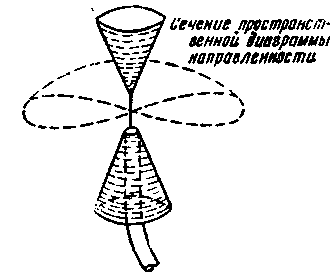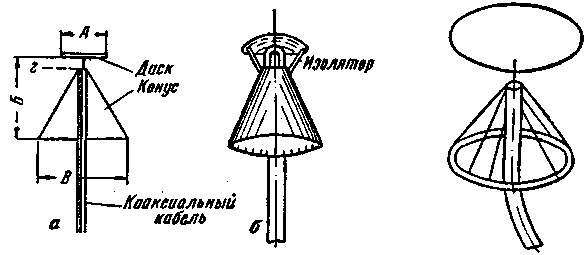Disco cone antenna. Encyclopedia of radio electronics and electrical engineering

Encyclopedia of radio electronics and electrical engineering / VHF antennas
 Comments on the article
Comments on the article
Compared to a coaxial antenna, a disk-cone antenna, which also has a circular radiation pattern and the same power supply, has a significantly larger bandwidth. Compared to a conventional dipole, the gain of this antenna is -3dB. This decrease in gain should not come as a surprise, since a disk-cone antenna has a correct radiation pattern over a very large bandwidth.
The design of the disk-cone antenna, shown in Fig. 11-40, subject to the specified dimensions and direct power supply over a coaxial cable with a characteristic impedance of 60 ohms, has a bandwidth of 85 to 500 MHz.

Ris.1
The cone is made in the form of a horn from a sheet of copper or some other material that is easy to solder. The power cable is laid inside the cone and its outer braid is soldered to the cone, and the cleaned segment of the inner core 100 mm long is soldered to the metal disk. The disk is held in a horizontal position by means of insulating props.
To establish long-distance radio communications in the ranges of 144-146 MHz and especially at 420-425 MHz, it is necessary to concentrate the radiation of electromagnetic energy in the form of a narrow beam and direct it as close as possible to the horizon. At the same time, it is also necessary to be able to establish radio communications with correspondents located in different directions from the radio station with a fixed antenna. For such a case, the antenna should have a radiation pattern in the form of an elongated figure-eight in the vertical plane, and in the form of a circle in the horizontal plane. A similar diagram can be obtained when performing a biconical antenna (Fig. 2), which is two metal cones, one of which is connected to the middle core of the cable, and to the other - its braid. The disadvantage of such an antenna is the need for symmetrical excitation.

Ris.2
A broadband biconical disk-cone antenna (Fig. 3), in which the disk plays the role of the upper cone, does not require symmetrical excitation. Table 1 shows the dimensions of disc-cone antennas designed for operation in amateur bands.
Table 1
| Working range frequencies, MHz |
Size mm |
| A |
Б |
В |
г |
| 30-90 |
1500 |
1 820 |
152 |
40 |
| 90-450 |
550 |
685 |
555 |
30 |
| 900 1-800 XNUMX |
80 |
125 |
85 |
10 |
With the selected antenna dimensions, it is desirable to work in the region of the lowest operating frequencies, since with an increase in the operating frequency, the angle between the direction of maximum radiation and the horizon increases. The antenna is powered by a cable with a wave impedance of about 60-70 ohms without matching devices. The disk is insulated from the cone, which can be grounded. For operation in the range of 38-40 MHz, the cone and disk are made of pins with a diameter of 3 - 5 mm (Fig. 4). The maximum distance between pins must not exceed 0,05L.

Ris.3,4
Literature:
1. K. Rothammel. Antennas. Moscow "Energy". 1979
2. F. Burdeyny et al. Shortwave handbook. From DOSAAF, Moscow. 1959
Publication: N. Bolshakov, rf.atnn.ru
 See other articles Section VHF antennas.
See other articles Section VHF antennas.
 Read and write useful comments on this article.
Read and write useful comments on this article.
<< Back
 Latest news of science and technology, new electronics:
Latest news of science and technology, new electronics:
A New Way to Control and Manipulate Optical Signals
05.05.2024
The modern world of science and technology is developing rapidly, and every day new methods and technologies appear that open up new prospects for us in various fields. One such innovation is the development by German scientists of a new way to control optical signals, which could lead to significant progress in the field of photonics. Recent research has allowed German scientists to create a tunable waveplate inside a fused silica waveguide. This method, based on the use of a liquid crystal layer, allows one to effectively change the polarization of light passing through a waveguide. This technological breakthrough opens up new prospects for the development of compact and efficient photonic devices capable of processing large volumes of data. The electro-optical control of polarization provided by the new method could provide the basis for a new class of integrated photonic devices. This opens up great opportunities for ... >>
Primium Seneca keyboard
05.05.2024
Keyboards are an integral part of our daily computer work. However, one of the main problems that users face is noise, especially in the case of premium models. But with the new Seneca keyboard from Norbauer & Co, that may change. Seneca is not just a keyboard, it is the result of five years of development work to create the ideal device. Every aspect of this keyboard, from acoustic properties to mechanical characteristics, has been carefully considered and balanced. One of the key features of Seneca is its silent stabilizers, which solve the noise problem common to many keyboards. In addition, the keyboard supports various key widths, making it convenient for any user. Although Seneca is not yet available for purchase, it is scheduled for release in late summer. Norbauer & Co's Seneca represents new standards in keyboard design. Her ... >>
The world's tallest astronomical observatory opened
04.05.2024
Exploring space and its mysteries is a task that attracts the attention of astronomers from all over the world. In the fresh air of the high mountains, far from city light pollution, the stars and planets reveal their secrets with greater clarity. A new page is opening in the history of astronomy with the opening of the world's highest astronomical observatory - the Atacama Observatory of the University of Tokyo. The Atacama Observatory, located at an altitude of 5640 meters above sea level, opens up new opportunities for astronomers in the study of space. This site has become the highest location for a ground-based telescope, providing researchers with a unique tool for studying infrared waves in the Universe. Although the high altitude location provides clearer skies and less interference from the atmosphere, building an observatory on a high mountain poses enormous difficulties and challenges. However, despite the difficulties, the new observatory opens up broad research prospects for astronomers. ... >>
 Random news from the Archive Random news from the Archive The influence of genes in the formation of aesthetic taste
26.05.2022
Possession of aesthetic taste is usually determined through a person's preferences and his own opinion about specific objects of art and culture. Despite a long-standing interest in the origin of taste and much research on the causes of individual differences in the "concept of beauty", sociologists still know little about the mechanism of preference formation.
In a new study, scientists from the University of Copenhagen (Denmark) assessed the contribution to the development of cultural preferences of family education, individual experience of a person, as well as his genes.
To investigate this issue, they conducted a survey among 1200 Danish twin pairs, 466 of which were monozygotic (homozygous or identical) and 734 were dizygotic (heterozygous or polyzygotic). Based on the results of the survey, the researchers determined the twins' preferences for 12 cultural events, divided into three categories: high-intellectual, low-intellectual and popular cultures.
Twin studies are a well-established method of revealing the relative influence of genes when comparing genetically identical monozygotic twins and dizygotic twins, who share only 50% of their genes.
According to the survey results, it turned out, for example, that 54% of the differences in respondents' tastes for highly intellectual culture (for example, for classics, opera, ballet and fine arts) can be explained by a genetic predisposition. And only 16% are associated with social influence within the family and upbringing. The remaining 30% correlated with external social factors and the person's personal experience.
Factors underlying addictions to low-intellectual culture (for example, going shopping or going to an amusement park) are more evenly distributed. At the same time, interest in popular culture, such as rock/pop concerts and stand-up performances, is mainly driven by individual experiences and external social influences outside the family.
When considering the actual participation of respondents in cultural events (that is, not their theoretical preferences, but what they really do and what they actually attend), the influence of family education turned out to be even weaker - more precisely, it was practically non-existent.
Instead, genetic predisposition plays a big role in choosing real hobbies. A similar situation, but with a slight bias towards personal experience, arises when testing the significance of genes in the development of broad musical and literary tastes in various genres.
|
 Other interesting news:
Other interesting news:
▪ Translator Pen
▪ The deepest dive in the history of sea expeditions
▪ Apple will change TV
▪ Waterblock EK-Quantum Velocity2
▪ Washing with almost no water
 News feed of science and technology, new electronics
News feed of science and technology, new electronics
 Interesting materials of the Free Technical Library:
Interesting materials of the Free Technical Library:
▪ section of the site Encyclopedia of radio electronics and electrical engineering. Article selection
▪ article by Eric Satie. Famous aphorisms
▪ article What wood was the Kon-Tiki raft made of? Detailed answer
▪ Quinoa article. Legends, cultivation, methods of application
▪ article Computer control of measuring equipment mechanisms. Encyclopedia of radio electronics and electrical engineering
▪ article Integral timer as an input stage operating from a long line. Encyclopedia of radio electronics and electrical engineering
 Leave your comment on this article:
Leave your comment on this article:
 All languages of this page
All languages of this page
Home page | Library | Articles | Website map | Site Reviews

www.diagram.com.ua
2000-2024







 Arabic
Arabic Bengali
Bengali Chinese
Chinese English
English French
French German
German Hebrew
Hebrew Hindi
Hindi Italian
Italian Japanese
Japanese Korean
Korean Malay
Malay Polish
Polish Portuguese
Portuguese Spanish
Spanish Turkish
Turkish Ukrainian
Ukrainian Vietnamese
Vietnamese



 Leave your comment on this article:
Leave your comment on this article: